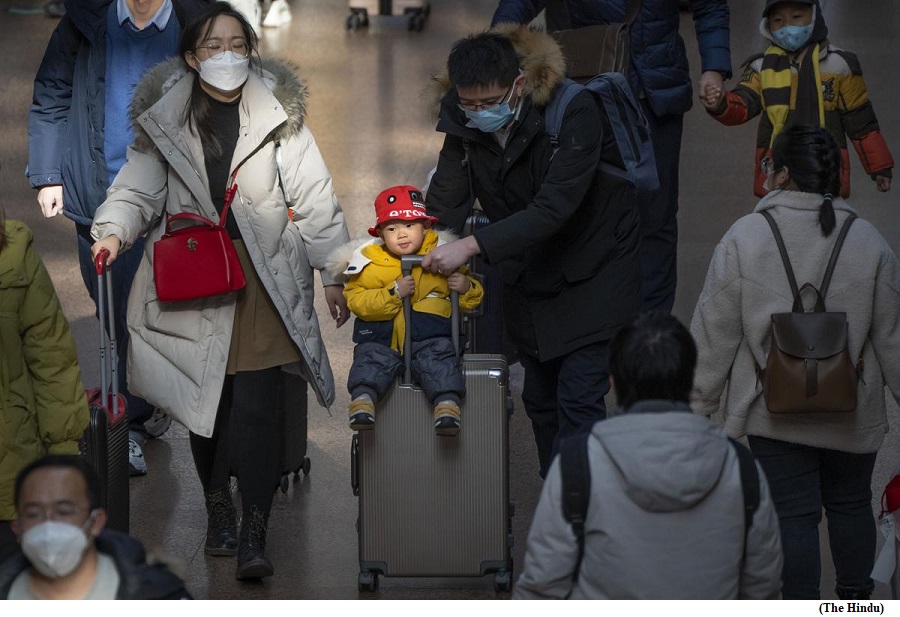Why is China’s population shrinking? (GS Paper 1, Social Issues)

Why in news?
- China’s National Bureau of Statistics announced on January 17, 2023 that the country’s population had fallen by 8, 50, 000 in the year 2022.
- This marked the first decline since 1961, when the country was in the midst of a four-year famine following the failed ‘Great Leap Forward’ campaign. Demographers say that with China’s population now having peaked, India is set to become the most populous nation in 2023.
What the reasons for this trend?
- Birth rates in China have declined since the 1980s and in the wake of the “one-child policy”, which introduced harsh measures such as forced abortions and high financial penalties. The Chinese government still defends the policy, arguing it spared China an additional 400 million births.
- But critics of the policy say the estimate is an exaggeration, when considering declining family sizes over time in many countries along with economic development and without similarly harsh measures, and when factoring into account the policy’s legacy of leaving behind a rapidly ageing society.
- If the one-child policy and its legacy has been one major factor, a second one, is that “young Chinese are marrying later, having fewer children, or forgoing having children altogether”, with the number of couples who married in China dropping from 13.46 million to 8.14 million in the period from 2013 to 2020.
- Meanwhile, the average age of first-time parents, in the three decade-period from 1990-2020, rose from 24.1 to 27.5.
- With a growing preference for getting married and starting families later, couples are choosing to have fewer children. In 2022, for the first time the number of births fell below the number of deaths. Births last year were 9.56 million, a more than 10% drop from 2021.
How has the Chinese government responded to the population crisis?
- To arrest the slide, China finally abandoned the one-child policy in 2016, by then, the policy had, in any case, included many exceptions, for instance for couples who were both only children or in rural areas for families where the first child was a daughter.
- The “two-child policy” introduced that year, however, failed to elicit the desired response. A government survey conducted that year found 70% attributed high costs of healthcare and education as a factor.
- Ahead of the rollout of the current five-year plan (2021-25), the Politburo discussed “major policy measures to actively address the ageing of population” and in 2021 rolled out a “three-child policy” including financial inducements for families with three children. It has also pledged to address the economic factors such as healthcare costs and education expenses, for instance by cracking down on expensive private education companies, which had become a booming industry.
- Harder to address, however, are the widening personal preferences for smaller families, a trend seen globally which also likely explains why the policies rolled out by China, as well as other countries such as Japan, have had limited impact in encouraging the public to have larger families.
- A more realistic policy emphasis would be to deal with what appears to be an inevitable trend following Japan’s experience, and to consider, for a start, raising the retirement age from the current 60 for men and 55 for women.
What will be the impact on China’s economy?
- China’s 16-59 working age population has continued to decline. As of the end of 2022, the number was 875 million, or 62% of the total population, down by around 75 million from 2010.
- The above-60 population was 280 million, or 20% of the total population, an increase of around 30 million in the same period.
- By 2050, the Chinese government estimates, the above-60 population will account for as much as 35% of the total population. Healthcare spending on this group will rise to 26% of the GDP by 2050, up from 7% in 2015.
Economic impact of a shrinking workforce:
- The size of China’s labour force already peaked in 2011 at 925 million, and is likely to drop to 700 million by 2050. The glut of labour from the rural heartland that powered China’s factories is already drying up.
- With wages rising, many factories in the lower end of the manufacturing spectrum are already moving out to Southeast Asia and Bangladesh. Chinese companies like e-commerce giant JD are already investing heavily in automation to deal with the coming labour crunch.
- Articles in the Chinese media have recently expressed longer term anxieties about factories moving out to India, that will this year become the world’s most populous country with a demographic dividend and labour force of a profile similar in age to China’s in 1980.


